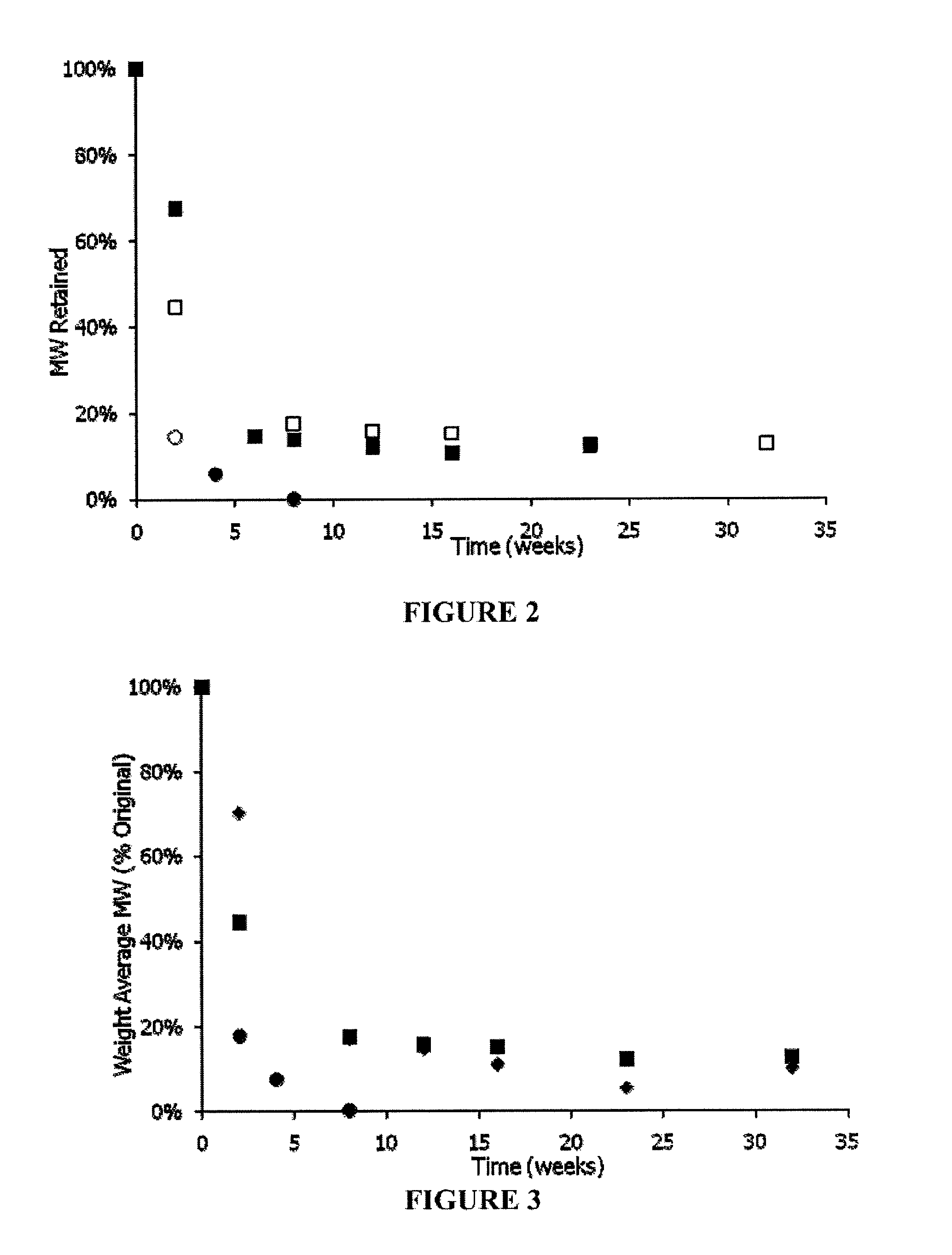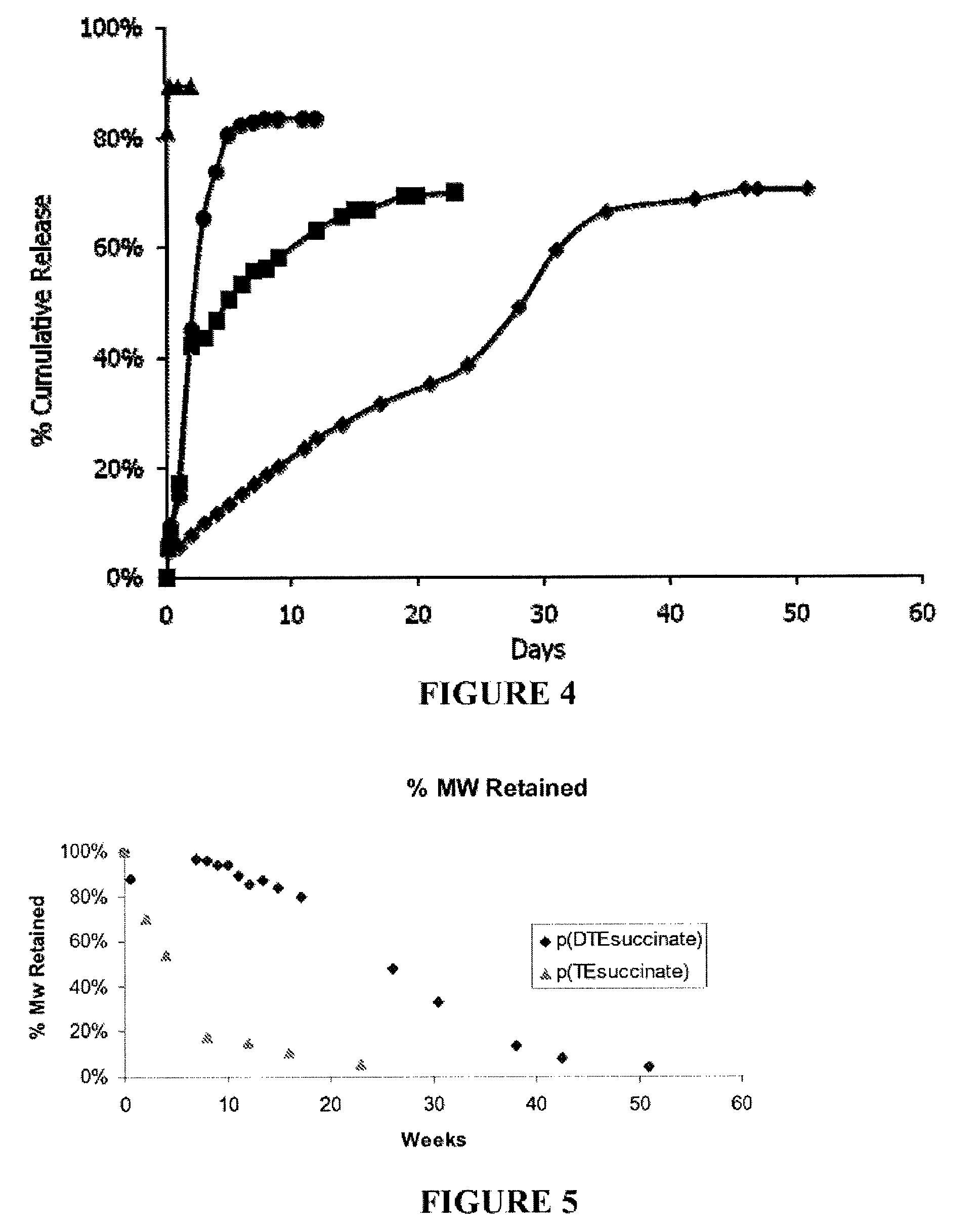Linear polyesteramides from aminophenolic esters
a polyesteramide and aminophenol technology, applied in the field of linear polyesteramides from aminophenolic esters, can solve the problems of increasing the complexity and cost of synthesis of these materials, prohibitively expensive regulatory hurdles, and the introduction of side chains, so as to prevent, treat or improve a disorder or condition in a patient. , the effect of easily varying the diacids and aminophenols
- Summary
- Abstract
- Description
- Claims
- Application Information
AI Technical Summary
Benefits of technology
Problems solved by technology
Method used
Image
Examples
example 1
General Methods
[0188]Molecular weight (Mol. Wt.) was determined by gel permeation chromatography (GPC) using 3 cross linked polystyrene columns run in DMF / 0.1% TFA at 0.8 ml / m and measured against polyethylene glycol standards using an R1 detector.
[0189]Tg values were determined by DSC using a heating ramp of 10° C. / m. Reported values are computed from a 2nd ramp cycle.
[0190]Proton nmr spectra were determined in D6MSO using tetramethylsilane as an internal calibration standard.
example 2
Synthesis of Strictly Alternating (Ab)n Polymers
A. Synthesis of p(TE-Dg-TE 35% PEG400-Bis-Succinate:Adipate)
Step 1: Synthesis of TE-Dg-TE
[0191]Tyrosine ethyl ester free base (0.256 4 moles; 53.65 g) was reacted with diglycolic acid (0.1275 moles; 17.1 g) in presence of HOBT.H2O and EDCI.HCl in N-methylpyrrolidinone (NMP) solvent. The reaction was carried out at 3-30° C. over a period of 16-18 h. Ethyl acetate was used during liquid-liquid extraction purification. Yield: 90%. Melting point: 128-129° C. Mass: 517.21(M+1).
[0192]NMR: 9.2-9.25 ppm (2H, singlet;), 8.25-8.32 ppm (2H, doublet), 6.95-7.15 ppm (4H, doublet), 6.6-6.7 ppm (4H, doublet), 4.4-4.5 ppm (2H, quartet), 4.0-4.01 ppm (4H, quartet), 3.85-3.98 (4H, quartet), 2.82-2.89 ppm (4H, multiplet), 1.08-1.16 ppm (6H, triplet).
Step 2: Synthesis of p(TE-Dg-TE 35% Peg400-Bis-Succinate:Adipate)
[0193]TE-Dg-TE (0.1 moles; 51.66 g) was reacted with PEG400-bis-succinic acid (0.035 moles; 22.27 g) and adipic acid (0.065 moles; 9.5 g) in pr...
example 3
Synthesis of Random AP—X Polmers
A. General Synthesis Route
[0200]The random polymers were generally synthesized as described in U.S. Pat. Nos. 5,216,115 and 5,597,507 using a carbodimide-mediated coupling reaction. Briefly, equimolar amounts of the aminophenol and the diacid were condensed in methylene chloride using DIPC as the coupling agent in the presence of 4-dimethylaminopyridium para-toluene sulfonic acid (DPTS). For polymers which contain a free acid moiety, a similar synthesis was conducted by first synthesizing the corresponding benzyl ester containing polymer (i.e., the aminophenol had a benzyl ester) followed by hydrogenation as described in U.S. Pat. No. 6,120,491 to yield the free acid-containing polymer. The polymers were usually isolated by repeated precipitation from isopropanol.
B. Synthesis of p(TE Diglycolate) Random
[0201]The synthesis was as generally described in Section A of this example, using tyrosine ethyl ester as the aminophenol and diglycolic acid as the d...
PUM
| Property | Measurement | Unit |
|---|---|---|
| glass transition temperatures | aaaaa | aaaaa |
| Tg | aaaaa | aaaaa |
| Tg | aaaaa | aaaaa |
Abstract
Description
Claims
Application Information
 Login to View More
Login to View More - R&D
- Intellectual Property
- Life Sciences
- Materials
- Tech Scout
- Unparalleled Data Quality
- Higher Quality Content
- 60% Fewer Hallucinations
Browse by: Latest US Patents, China's latest patents, Technical Efficacy Thesaurus, Application Domain, Technology Topic, Popular Technical Reports.
© 2025 PatSnap. All rights reserved.Legal|Privacy policy|Modern Slavery Act Transparency Statement|Sitemap|About US| Contact US: help@patsnap.com



